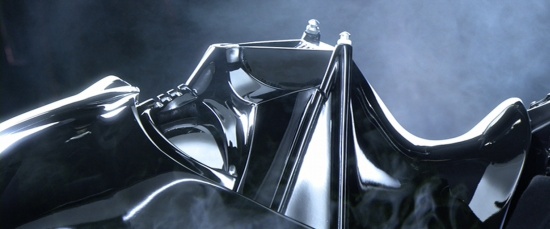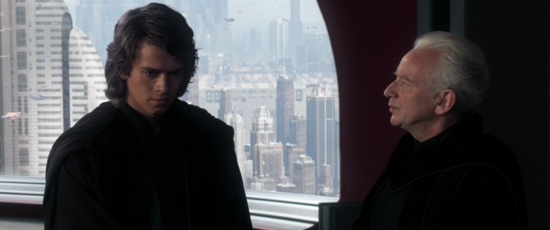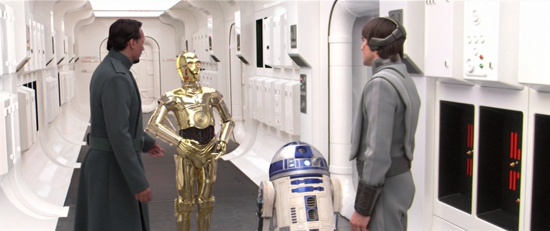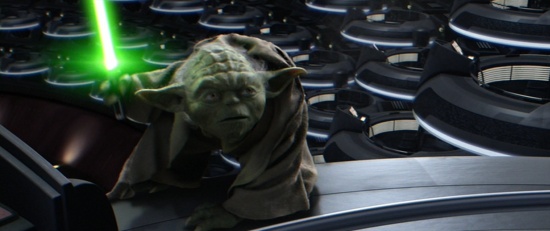Revenge of the Sith (George Lucas, 2005)

You could hate Revenge of the Sith, if you wanted to.
The night before seeing it, I re-watched much of the original Star Wars, and was captured once again – as always – by its magic. There is a strange alchemy at work in Star Wars and The Empire Strikes Back (and sporadically in Return of the Jedi) that the prequels haven’t recaptured. For all sorts of reasons, the prequels are not the return to that universe we all hoped for when the prequels were originally announced: they look different and feel different. If you measure the prequels against the originals, and dwell on what’s missing, you can’t help but mourn for what the prequels could have been. Revenge of the Sith is still not the journey back to that feeling of glorious fantasy that Star Wars and Empire Strikes Back achieved. As such, it isn’t everything that either Star Wars fans or casual moviegoers might have hoped, and there will be those who hate it for that.
And yet… if you can put the originals out of your mind, and go with it on its own terms, then Revenge of the Sith is immensely rewarding. It is the best of the prequel films by a comfortable margin, and an excellent movie in its own right. It is, finally, a Star Wars prequel to love. It is not completely free of the flaws that bedevilled the earlier prequels, but it is also exciting, spectacular, engrossing, occasionally funny, and – here’s the surprising one – actually moving. While fans have been prepared by the positive reviews in the fortnight or so before its release, I think the more disinterested filmgoers who wander in to Revenge of the Sith almost against their better judgment are going to be surprised by the film Lucas has sprung on them. Who knew (rather than hoped) that Lucas had a film of this calibre left in him?
I say that as an enormous Star Wars fan, and perhaps you should therefore treat my words with caution. But I like to think that I am not an uncritical fan. I hated The Phantom Menace, and while I was amongst a minority who enjoyed and positively reviewed Attack of the Clones, I still stand by my review of that film as a fair assessment of both its weaknesses and its under-recognised virtues. What has not often enough been acknowledged by the critics who savaged the prequels is that the new trilogy is fundamentally different in its approach to the originals. One of the things that was frustrating about The Phantom Menace and Attack of the Clones was that their manifest shortcomings revived a whole strain of lazy, complacent criticism that simply wrote the Star Wars films off as extravagant and empty-headed displays of special effects. Lucas’ sometimes atrocious execution of his vision has hampered the recognition of what he was up to in the new Star Wars films, which are in many ways much more ambitious in their intent than the originals. Revenge of the Sith sees Lucas’ execution finally start to rise to match his ambition, and hopefully this will lead to some re-evaluation of what Lucas was getting at with these films.
Unlike the originals – which are fairly straightforward in their storytelling – the new films are an extended exercise in dramatic irony. They are, after all, shaped by victories that doom the galaxy. The Phantom Menace finishes with a joyous, brightly lit street parade, but the happy tone of the characters is at odds with what the audience knows to be the truth: that the real villain has escaped and has taken his first step towards enslaving the galaxy. Similarly, Attack of the Clones finishes with a great military victory that is made possible by the surrender of democratic powers and the creation of an army that will ultimately place the galaxy under the rule of a militarily backed dictatorship. In Revenge of the Sith the real villain – the “Phantom Menace” – is finally unmasked, and suddenly the innocent, childlike adventure that we started with (in which children raced in computer-game style drag races and hung out with cartoon characters) is revealed to have been leading down a very, very dark path indeed. Star Wars is subtitled “A New Hope”: this is the film in which all hope is lost.
At the centre of the film, of course, is the transformation of Anakin Skywalker into Darth Vader. This is tricky material, because Darth Vader is not simply a villain: he is a supervillain. What I mean by that is that he is villainy taken into a different realm, a realm that only exists in pulp or genre narratives: an over-the-top icon of evil, like Ernst Stavro Blofeld or a comic book villain. We have all seen movies such as The Godfather that show how a good person can be brought down to mere villainy, but how do you tell an origin story for a supervillain? Comic books and their film adaptations tend to rely on a contrivance: a character gets dropped in a bucket of goo, or exposed to a mysterious energy field, and bang – he’s a supervillain. Revenge of the Sith, however, attempts to credibly depict a troubled but fundamentally decent man making a choice to become a black-swathed killing machine, and that’s a very tricky (almost impossible) assignment. The film doesn’t quite get there: it’s still hard to completely accept Anakin’s descent. Yet Lucas has come very close to making Anakin’s choice credible and even understandable. It isn’t, as some reviewers have been saying, all about a woman: instead, there is a fatal alignment of circumstances that combine to push Anakin over the edge.

Of course, Anakin doesn’t just jump over that precipice: he is pulled. Central to the success of Revenge of the Sith is Ian McDiarmid as Chancellor Palpatine. McDiarmid has until now had a small role in the prequels: as in the original trilogy, his character has mostly been held back until the third movie, hiding behind a string of second-tier villains. (I’m not even sure that many of the more disinterested viewers have drawn the link between Palpatine and the original trilogy’s Emperor). Yet Revenge of the Sith, even more than Return of the Jedi, is his moment on centre stage. McDiarmid is one of the few actors who has really known what to do with Lucas’ dialogue. In his guise as Palpatine, McDiarmid plays the master manipulator, and his line delivery is full of an arch self-satisfaction. Once he is unmasked as a Sith Lord, he spits his lines out with delicious venom. Years ago, I remember being a little let down with the Emperor in Return of the Jedi, but McDiarmid’s portrayal of the character has grown on me to the point where I now value him as the most crucial links between the old films and the new. Lucas’ writing for Palpatine in this film is some of the smartest in the series. Palpatine leads Anakin astray with a chillingly seductive logic, and by being the only character who can offer any understanding for the twisted thoughts in Anakin’s mind. The scene where the penny drops and Anakin finally realises that Palapatine is the Sith Lord that the Jedi have been looking for is a great moment, made all the more dramatic and tragic by Anakin’s unexpected choice to do the right thing. As others have noted, Palpatine has a Godfather-like quality to him, highlighted by a Coppola-esque sequence in which Palpatine and Anakin confer at the opera. (And note the sly wit inherent in the sequence: a space opera in a space opera.)
Unlike the previous installments, however, this time there is depth to the performances across the cast, and you can actually engage with the characters they play. Ewan McGregor has gotten better in each film as Obi Wan, and here he is not only convincing as the younger version of Alec Guiness, but also as a likeable and engaging hero. For the first time we really see a convincing friendship between Obi Wan and Anakin, which makes it doubly effective when Obi Wan’s trust is betrayed. Hayden Christiansen is much better this time as Anakin, turning that off-putting manner he had in the previous film into a fully rounded portrayal of a deeply disturbed man. Natalie Portman’s part is substantially reduced, but she does better with the scenes she has, shaking off her overly formal and stilted manner. Christopher Lee bows out fairly quickly as Dooku, but it’s a great little part. (I particularly liked the moment where Dooku realises too late that his alliance with Sidious is not going to work out.)
At a storytelling level, too, the film works much better than its immediate predecessors. The tendency of The Phantom Menace and Attack of the Clones to get distracted from the main story arc pays an unexpected dividend here: Lucas has left so much story to get through in the last film that he can’t afford to mess around with unnecessary characters. Jar Jar all but disappears (although contrary to just about every other reviewer, I’m fairly sure he does get one line of dialogue, although it’s buried down in the sound mix and his face is away from camera), and even Chewbacca’s much-heralded return to the series really amounts to only a handful of shots. The film creates something of a problem for itself by starting a battle on Kashyyyk that it doesn’t have time to resolve, but it’s a minor complaint. It is structured with much more confidence, with the jarring and arbitrary cuts between locations that bothered so many in Attack of the Clones replaced with an artful cross-cutting between different locations for dramatic effect. The opening sequence, in which Anakin and Obi Wan attempt to free Palpatine, is great fun, with the film’s only real moments of comedy relief. The production design is as good as ever, with some spot-on recreations of sets from the original trilogy (like that pictured below). While it still doesn’t look like the original films (due to the all-pervasive CGI effects) you can feel the gap between the two trilogies being narrowed.

None of which is to say that the film is without flaws. There are a few unresolved plot points between this and the original trilogy, and the wiping of C-3PO’s memory is handled in a glib and callous way (oddly, R2-D2’s memory seems to be spared, which doesn’t make a lot of sense). While the dialogue is better written and delivered across the board (there have been persistent rumours that playwright Tom Stoppard undertook a dialogue polish), there remain a few clunky moments. One romantic scene between Anakin and Padme, in particular, revives all those suppressed memories of the worst parts of Attack of the Clones. Lucas tweaked a couple of the sillier bits of that film for the DVD release, and two moments in Revenge of the Sith cry out for excision: an idiotic line of dialogue about Padme’s medical condition towards the end; and the final moment of Vader’s otherwise chilling transformation scene, which is unintentionally comical. Generally, however, the film lacks the embarrassing, gaping flaws of its predecessors. For the most part, Revenge of the Sith is a grim but single-minded film with a great narrative drive.
It would be overstating the case to say that Revenge of the Sith redeems its predecessors: even the Dark Side is not that powerful. It has, however, finally shown where Lucas was headed all along. The film snobs who have always considered themselves above Star Wars might choke on the thought, but Revenge of the Sith is a very intelligent film. The minor flap that has arisen in the media about the film’s politics (with suggestions that it is explicitly anti-Bush) is a sign that critics are playing catch-up in spotting themes that have been clear since The Phantom Menace in 1999. The prequel trilogy’s timely message is that we surrender our liberties at the risk of tyranny, and that doing wrong in the name of expediency is a path to evil. Lucas has been hatching this plot arc since the 1970s, but it seems particularly apt in the post September 11 world, where threats to security are used to justify incursions of civil rights. I have seen criticisms of Lucas for making this point, as if he has suddenly thrown in an anti-Bush tirade that had no basis in what came before. Instead of criticising Lucas for jumping on a political bandwagon (as they see it) and bending his story to resemble the real world, such pundits would be better to ask why it is that the real world suddenly looks so like Lucas’ three-decade old vision of a democracy gone rotten.

As important as I think Lucas’ message is, however, there is never a sense this time around that you are being lectured. Indeed, Lucas has great fun with his central idea when Yoda and Palpatine square off on the floor of the Galactic Senate: improbably, he has pulled of a metaphoric action sequence. Such unlikely successes recur throughout the film. Despite its dark tone, Revenge of the Sith will, I think, reunite the Star Wars fans with general audience by reviving interest in the franchise. And while it may seem a shame that the series would come to a close just when Lucas has made a good one, there is an easy remedy for such disappointment. After all, if you liked Episode III, there’s no waiting for the sequel.
Related Items
See all my Star Wars content here.